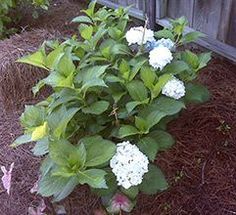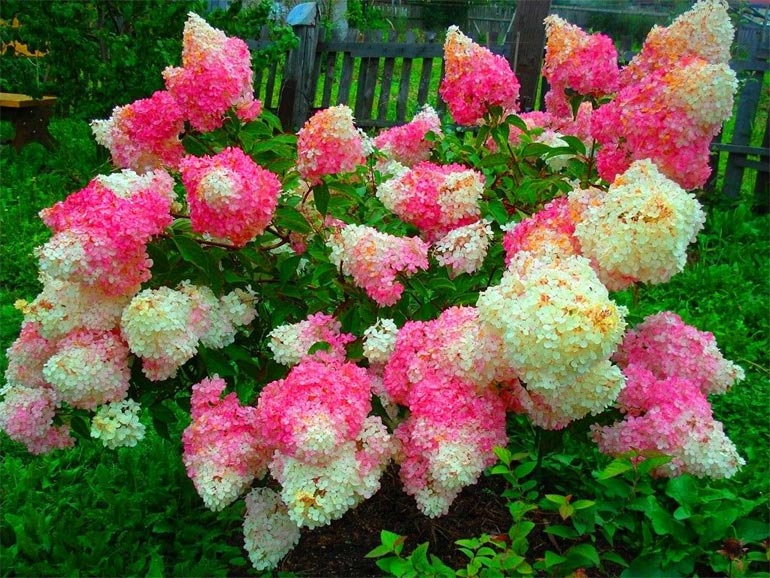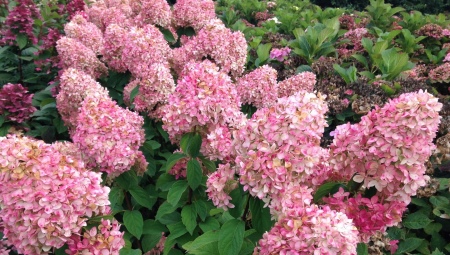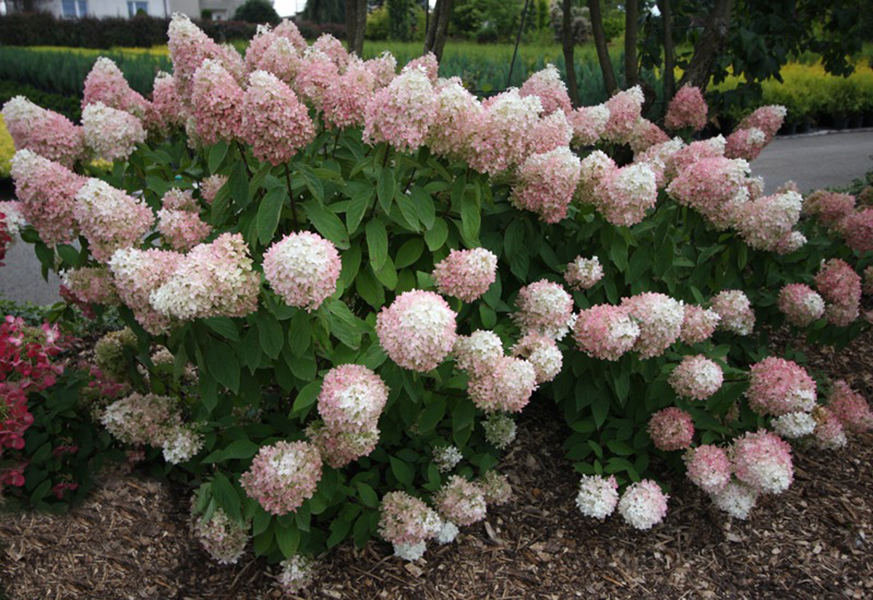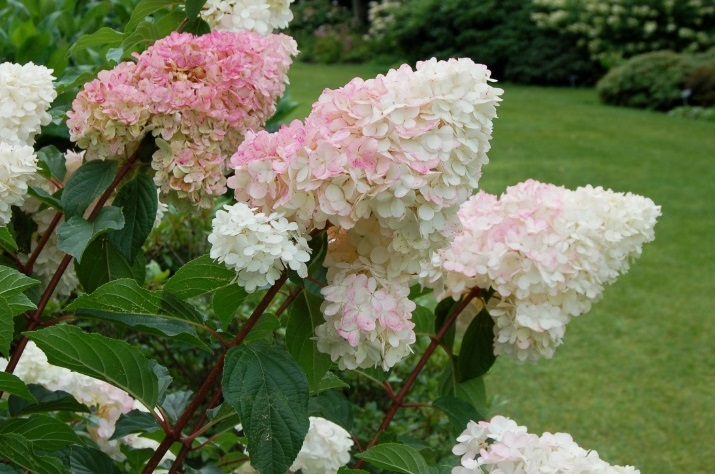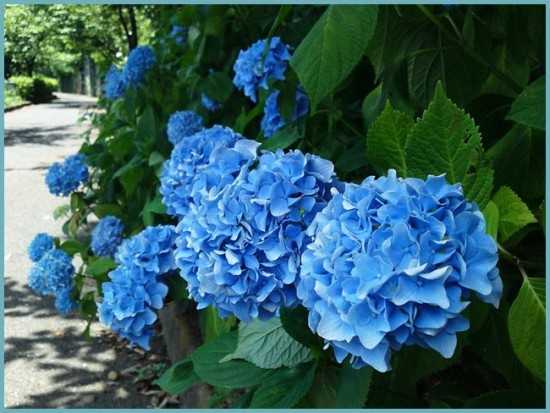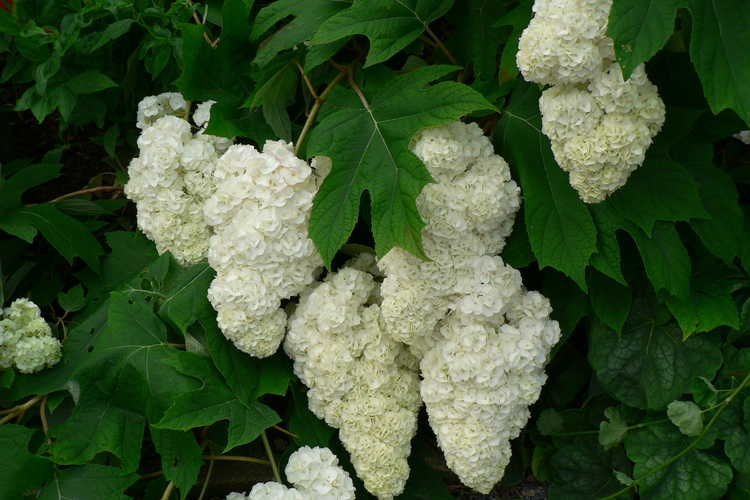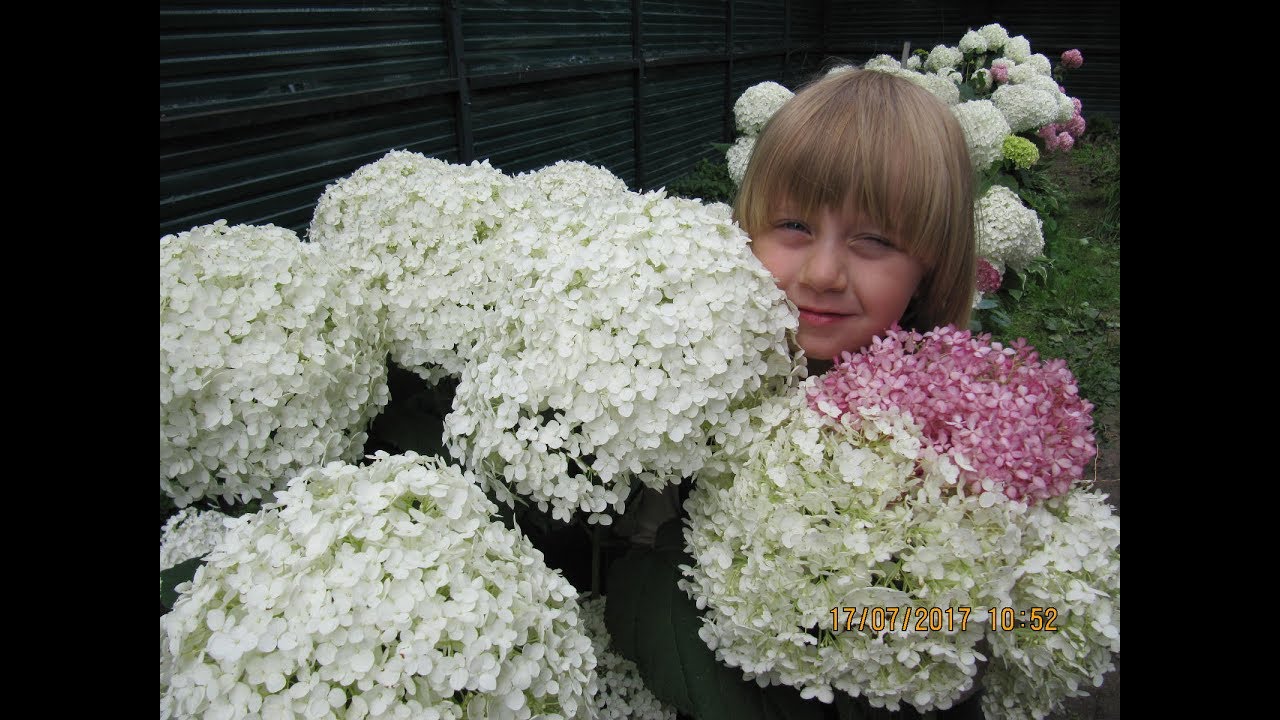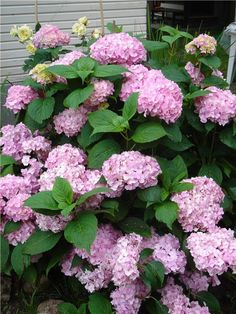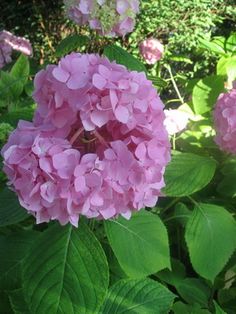Care
Like other hydrangea varieties, Moonlight is easy to care for. It consists in abundant watering, feeding and pruning.
When caring for a plant of the first year, you should not allow flowering. By trimming the buds, you can get a strong, healthy bush. The flowering will be more intense next year.
Watering mode
Hydrangea Magical moonlight loves moist soil. In the first year after planting, it should be watered every day. In subsequent years, watering can be reduced.
Important! Do not allow the earthen coma to dry out near the roots of the bush. This can lead to the death of the plant.
In hot summer, at least 30 liters of water should be poured under the bush. Watering is carried out at the root. After abundant watering, it is advisable to mulch the soil to prevent rapid evaporation of moisture.
You can mulch with the following materials:
- peat;
- manure;
- straw;
- sawdust.
To retain moisture in the near-stem circle, ground cover plants are planted around the shrub. It can be verbena, saxifrage or bryozoan.

Hydrangea cuttings
Top dressing
Top dressing should be carried out throughout the growing season. During this time, you need to carry out 3 dressings:
- In the spring, before the buds swell, urea or other nitrogen-containing fertilizers are applied.
- In summer, during the beginning of flowering - superphosphate, urea, potassium sulfate.
- In the fall, before preparing for winter - fertilizers with phosphorus and potassium.
In summer, manure and mineral complexes are also used as fertilizer. Manure should be infused with water before spreading. The infusion is made at the rate of 1 kg of manure per 10 liters of water. The working solution is made in a ratio of 1 to 2 and the plant is watered with it.
Important! Fertilizers are best applied in a groove made around the hole. After placing fertilizers in it, the groove is closed
During flowering
Before flowering, it is necessary to inspect the bush and remove broken and diseased branches.
During flowering, it is important to provide the plant with moisture and nutrients. For such a simple care, it will thank you with lush flowering.
Don't be afraid to prune your hydrangea in the spring. This species lays flower buds on the shoots of this species. After pruning in the spring before sap flow, you can get a lush, bud-strewn bush.
During the rest period
Before the winter period, the hydrangea must be fed.

Hydrangea in bloom
This is done in late September - early October. During winter dormancy, you need to ensure that the bush is covered with snow.
Preparing for winter
Panicle hydrangea Moonlight frost-resistant. It can withstand frosts down to -30 ° C. Therefore, shelter for the winter is required only for plants in a strip with severe winters. In an area where winters are milder, it is only necessary to cover the seedlings of the first year. To protect them from frost, their roots are covered with straw or peat. The protective layer should be 20 cm thick. From above, the shrub is covered with agrofibre.
Having planted in the garden or at the summer cottage hydrangea Magic Moonlight, you can create an amazing landscape. Whether it is a single composition or a hedge, the site will attract the eyes of passers-by. The delicate scent of flowers will fill not only the air, but also the soul of the hosts and their guests.
Popular varieties in gardening with photos
There are several dozen varieties of panicle hydrangea, but below we will consider the most popular varieties for the garden.
Anabelle
A voluminous shrub up to 1.5 m high with a wide rounded crown, consisting of large bright green leaves. Blooms from June to late summer. Lush inflorescences with a diameter of 15-20 cm are greenish at the beginning of flowering, then they acquire a uniform white color.
Vanilla Fraise
A unique variety that will become the pearl of the garden. The shrub is lush and spreading, about 1.5 m high, blooms profusely from early August to late autumn.Admire the dense, pyramidal-shaped inflorescences 25-30 cm long, painted white at the top and lilac-pinkish below.
Grandiflora
This variety is classic in horticultural culture and the most frost-resistant. The height of the shrub reaches 2 m, the shoots are straight and strong, the leaves are large. Inflorescences - creamy white, sometimes pinkish panicles up to 30 cm long, forming at the tops of the shoots. Bloom lasts from July to September.
Great Star
An extraordinary variety with very large (up to 5 cm in diameter) snow-white flowers, the petals of which are similar to the lobes. The inflorescences are spherical, flattened, and consist of two types of flowers: with long petals and several hundred small fertile flowers without aroma. The bush is voluminous, reaching a height of 2-3 m.
Diamond Rouge
The brightest representative of the paniculate species. The crown of the shrub is wide, the height is up to 1.2 m. The inflorescences are large (up to 35 cm), rounded at the top, changing their color from white to deep red. The variety blooms in July. In autumn, the foliage becomes orange in color.
Limelight
A well-known Dutch variety that has received worldwide recognition. The plant is vigorous, reaches a height of 2 m in the garden, but can also be grown as a pot culture. Blooms from July to late September. The flowers are lemon-white, greenish at the top, collected in oblong panicles 25-30 cm long.
Magical Sweet Summer
A low (up to 1.2 m) shrub with a dense crown and smooth, groaning shoots. The shade of the inflorescences changes depending on the soil, weather and time. At the initial stage, the flowers are greenish, then they become pinkish at the top, and cream below.
Pink Diamond
Lush shrub up to 2 m high with erect thin shoots forming large (up to 30 cm) cone-shaped inflorescences. Flowering lasts from early July to mid-autumn. The flowers are pinkish when blooming, over time they become bright red and exude a strong aroma.
Pinky Winky
Tall (up to 2 m) shrub with strong, but thin and slightly leafy shoots. Blooms from mid-summer to late October. Inflorescences are loose, you can see each flower. The color is two-tone - in the lower part, the petals are purple, and the upper half is creamy white.
Sundae Fraise
Sprawling shrub 1-1.5 m high with straight shoots inclined to the ground. It blooms early, from June to July. The color of the inflorescences gradually changes from white to purple-purple. In 2010, the variety was awarded a silver medal at a flower show in Holland.
Silver Dollar
A lush bush with a spreading crown up to 2.5 m in diameter and large pointed leaves. Blooms in July. Inflorescences are conical, up to 30 cm in length, white-cream at the bottom, lemon-yellow at the top.
Tender Rose
A rare large-leaved variety with bright flowers, collected in decorative, rounded at the top of the inflorescence of a rich pink color, 20 cm in length. A voluminous shrub, up to 2 m high, blooms from July to early autumn, prefers partial shade.
Phantom
An interesting and very decorative variety with huge, up to 40 cm multi-colored inflorescences - at the beginning of flowering they are white with greenish-yellow blotches, later the white color turns pink, but the greenish color remains, which results in a very extraordinary color. Shrubs bloom until autumn, even Siberian frosts can easily withstand.
Everest
An elegant two-meter shrub with large dark green leaves and powerful shoots. Blooms from mid-summer. Inflorescences are long, up to 40 cm, rather loose. The color is pinkish-white, with time the pink color turns purple.
Unique
The variety was bred in the middle of the last century by a married couple from Belgium. A fast-growing shrub, erect and sparsely leafy shoots. Inflorescences are long (30-40 cm) and loose, white, sometimes pinkish. Despite being inconspicuous, the cultivar was awarded an AGM award from the Royal Horticultural Society.
Description of hydrangea variety Summer Snow
The main distinguishing characteristic of this variety is the flowering time: from the end of June to the beginning of October. With proper care, the plant can grow to a height of over 3 meters.

Hydrangea Summer Snow is distinguished by lush white inflorescences
Large dark green leaves with pointed ends have a matte surface, which is why a bush with snow-white flowers against the background of foliage looks like it is sprinkled with snow. Due to this property, this plant variety was named Summer Snow, which means "summer snow" when translated.
Interesting! This hydrangea can also be found in natural conditions, most often in China, Japan and Sakhalin.
The inflorescences are shaped like a pyramid. They have a round top and bloom for the first time in the middle of summer. Usually at the first flowering the bud is snow-white in color. On the second bloom, after about three weeks, the color turns pale pink. It blooms for the third time after the same period of time, and the inflorescence acquires a bright pink color.

At the first flowering, the hydrangea buds are snow-white
Description and features of panicle hydrangea
Panicle hydrangea (lat.hydrangea paniculata) is a perennial deciduous shrub, reaching a height of 2-3 m without pruning, in natural conditions it can grow up to 10 m. The roots are shallow, lie superficially, going far beyond the size of the crown. The leaves are large, elliptical or ovoid, up to 12 cm in length, pubescent below.
 Panicle hydrangea - perennial deciduous shrub
Panicle hydrangea - perennial deciduous shrub
The difference between panicle hydrangea and other species is that conical inflorescences, like lilacs, are only much larger and brighter. The flowers are small (about 2 cm in diameter), 4 or 5-petaled, collected in lush pyramidal panicles up to 25 cm long.The color range is represented mainly by white and pinkish shades, but there are several varieties with rich red and burgundy color.
Hydrangeas bloom for 4-5 years of life. Bloom from mid-summer to late autumn. After flowering, the fruit is formed - a cracking box 3 mm long with a huge number of small, but very viable seeds. This type of hydrangea came to us from China and Japan, although its area of growth includes not only Asian countries, but also the American continent.
Features of growing hydrangea paniculata
All hydrangeas, despite their external differences, put forward the same requirements for planting and further care.
Correct fit
It is better to plant a hydrangea on the site in spring, so that during the summer period the seedling has time to take root and adapt. In the south, where there are no cold winters, planting can be done in the fall. Seedlings in containers can theoretically be planted at any warm time, however, in the summer heat, the chances of successful rooting are still small, so it is better to postpone this process until the spring.
 Seedlings in containers are characterized by high survival rate
Seedlings in containers are characterized by high survival rate
Hydrangeas are thermophilic plants, but in the scorching sun their leaves quickly wither, and luxurious inflorescences become faded. Therefore, for planting, it is better to choose a windless area that is well lit, but the other half of the day is in light partial shade. Here the shrub is difficult to please, since in the bright sun the duration of flowering is reduced, and with a lot of shading, fewer peduncles are formed.
As for the composition of the soil, it must be breathable, fertile and necessarily slightly acidic. Ordinary garden soil can be acidified by adding peat. The same effect is achieved by mulching the soil with sawdust, wood chips or needles.
Video "Planting hydrangea paniculata"
This video explains how to plant a hydrangea seedling outdoors.
The nuances of reproduction and transplantation
The propagation of hydrangeas is carried out mainly by cuttings. Cuttings are cut from young, non-flowering shoots in early summer. You can use the tops of the branches after pruning, the main thing is that there are at least 3 living internodes on each workpiece.The lower cut of the cutting is treated with a growth stimulant, then planted in a moistened sandy substrate. The rooting process lasts about a month, and in August, new seedlings can be transplanted onto the site.
 The propagation of hydrangeas is carried out mainly by cuttings
The propagation of hydrangeas is carried out mainly by cuttings
Hydrangeas also reproduce well by layering. To do this, in the summer, the lower shoot is bent to the ground, fix it and sprinkle it with earth at the site of the internode. The roots are formed within 1-1.5 months, after which the young seedling is separated from the mother plant and planted.
The process of transplanting a seedling to a new location takes 2 days. On the first day, a hole is dug 40-50 cm deep, part of the land is mixed with peat and humus in a ratio of 2: 1: 1, 1 tbsp is added here. l. superphosphate and potassium sulfate. The soil mixture is poured into the pit by a third, after which 1-2 buckets of water are poured. The planting itself is performed on the second day, when all the moisture is absorbed.
Subtleties of care
Hydrangea is easy to care for. The whole process consists of three main activities: watering, fertilizing and pruning. Young unrooted seedlings should be watered regularly to prevent the soil from drying out. Adult shrubs are watered depending on the weather: in the summer heat, it is enough to moisten the soil once a week at the rate of 2-3 buckets per bush, towards autumn watering is gradually reduced. To maintain moisture, the soil is mulched with wood chips or sawdust.
In order for the inflorescences to acquire a bright pink hue, it is recommended to add 1 tsp to the water for irrigation. citric acid in a bucket. A bluish tint to the inflorescences can be given by adding 30-40 g of aluminum sulfate (aluminum alum) to the water.
Author's advice
Hydrangeas are fed 3-4 times per season:
- with the beginning of the growing season - organic matter, for example, liquid manure;
- during the formation of buds - a mineral complex with a potassium content (superphosphate);
- the third time they are fed during active flowering - special fertilizers for ornamental flowering plants;
- before wintering - mineral composition with potassium and phosphorus.
Shrub pruning is carried out in order to give the crown a neat and attractive shape. It is held in the spring. In the first year, the plant is cut low, up to 2-3 buds, due to which the crown thickens and takes on a magnificent shape. In subsequent years, the strongest shoots are shortened to 4-5 buds, and the weak and damaged ones are cut out completely. Anti-aging pruning is carried out in the fall with a frequency of 1 time in 3-4 years.
 Recommended pruning scheme for deciduous shrubs
Recommended pruning scheme for deciduous shrubs
Preparing for winter
Garden hydrangeas are quite winter-hardy, they can withstand frosts down to -30 ° C, so no covering material is required for adult bushes. It is enough just to mulch the root zone with a layer of humus, fallen leaves or peat 15 cm thick. Young plants, especially in the year of planting, need to be covered with a frame shelter, which will create greenhouse conditions in winter.

